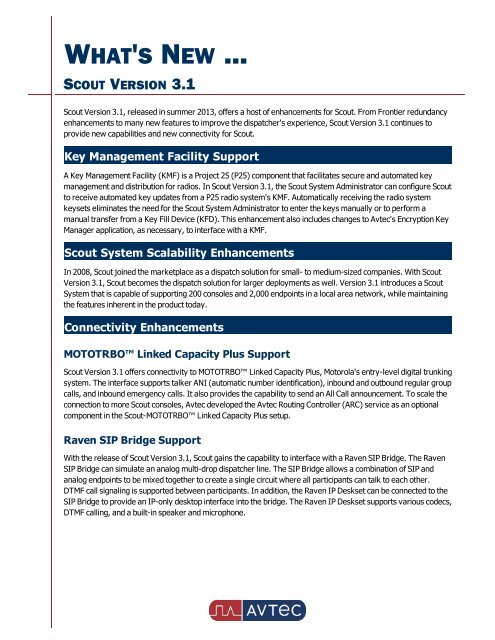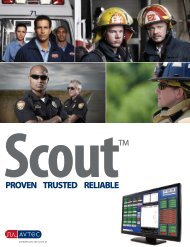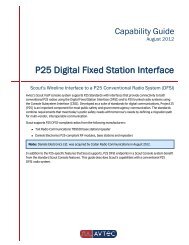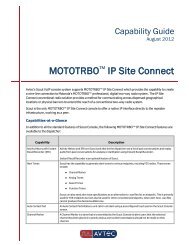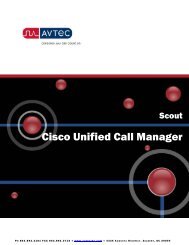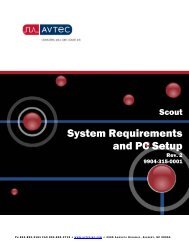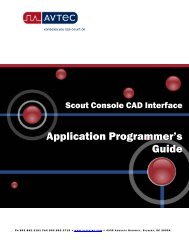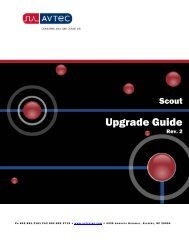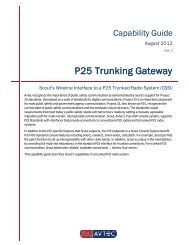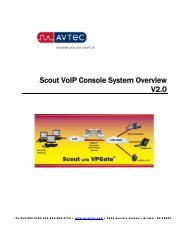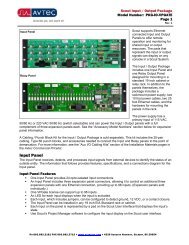What's New Scout Version 3.1 - Avtec Inc.
What's New Scout Version 3.1 - Avtec Inc.
What's New Scout Version 3.1 - Avtec Inc.
You also want an ePaper? Increase the reach of your titles
YUMPU automatically turns print PDFs into web optimized ePapers that Google loves.
WHAT'S NEW ...SCOUT VERSION <strong>3.1</strong><strong>Scout</strong> <strong>Version</strong> <strong>3.1</strong>, released in summer 2013, offers a host of enhancements for <strong>Scout</strong>. From Frontier redundancyenhancements to many new features to improve the dispatcher's experience, <strong>Scout</strong> <strong>Version</strong> <strong>3.1</strong> continues toprovide new capabilities and new connectivity for <strong>Scout</strong>.Key Management Facility SupportA Key Management Facility (KMF) is a Project 25 (P25) component that facilitates secure and automated keymanagement and distribution for radios. In <strong>Scout</strong> <strong>Version</strong> <strong>3.1</strong>, the <strong>Scout</strong> System Administrator can configure <strong>Scout</strong>to receive automated key updates from a P25 radio system's KMF. Automatically receiving the radio systemkeysets eliminates the need for the <strong>Scout</strong> System Administrator to enter the keys manually or to perform amanual transfer from a Key Fill Device (KFD). This enhancement also includes changes to <strong>Avtec</strong>'s Encryption KeyManager application, as necessary, to interface with a KMF.<strong>Scout</strong> System Scalability EnhancementsIn 2008, <strong>Scout</strong> joined the marketplace as a dispatch solution for small- to medium-sized companies. With <strong>Scout</strong><strong>Version</strong> <strong>3.1</strong>, <strong>Scout</strong> becomes the dispatch solution for larger deployments as well. <strong>Version</strong> <strong>3.1</strong> introduces a <strong>Scout</strong>System that is capable of supporting 200 consoles and 2,000 endpoints in a local area network, while maintainingthe features inherent in the product today.Connectivity EnhancementsMOTOTRBO Linked Capacity Plus Support<strong>Scout</strong> <strong>Version</strong> <strong>3.1</strong> offers connectivity to MOTOTRBO Linked Capacity Plus, Motorola's entry-level digital trunkingsystem. The interface supports talker ANI (automatic number identification), inbound and outbound regular groupcalls, and inbound emergency calls. It also provides the capability to send an All Call announcement. To scale theconnection to more <strong>Scout</strong> consoles, <strong>Avtec</strong> developed the <strong>Avtec</strong> Routing Controller (ARC) service as an optionalcomponent in the <strong>Scout</strong>-MOTOTRBO Linked Capacity Plus setup.Raven SIP Bridge SupportWith the release of <strong>Scout</strong> <strong>Version</strong> <strong>3.1</strong>, <strong>Scout</strong> gains the capability to interface with a Raven SIP Bridge. The RavenSIP Bridge can simulate an analog multi-drop dispatcher line. The SIP Bridge allows a combination of SIP andanalog endpoints to be mixed together to create a single circuit where all participants can talk to each other.DTMF call signaling is supported between participants. In addition, the Raven IP Deskset can be connected to theSIP Bridge to provide an IP-only desktop interface into the bridge. The Raven IP Deskset supports various codecs,DTMF calling, and a built-in speaker and microphone.
Dispatcher EnhancementsDispatcher-Defined Radio GroupsA new feature with <strong>Scout</strong> <strong>Version</strong> <strong>3.1</strong> allows the dispatcher to create radio groups instantly, as needed. The <strong>Scout</strong>Administrator can configure a Dynamic Group pad for the dispatcher's <strong>Scout</strong> User Interface. The pad gives thedispatcher the capability to create a radio group for any radios that are in Select by pressing and holding the pad.The <strong>Scout</strong> System Administrator configures, on a per-console basis, the length of time the dispatcher must holdthe Dynamic Group pad to form the group.When the dispatcher presses and holds the Dynamic Group pad, all endpoints that are in Select are merged into agroup. The pad text then displays the number of radios in the group. If the dispatcher places more lines into Selectand wants to add them to the group, the dispatcher simply presses and holds the Dynamic Group pad again andthe group is updated to include the endpoints that are in Select. Once the endpoints are part of the group, thedispatcher can move the endpoints in the group to other states simultaneously.For a radio endpoint to become a member of the group, the radio must be configured for Simul-select. A group islimited to the maximum number of endpoints that can have audio at one time. <strong>Scout</strong> clears dynamic groups uponconsole log out or exit. This feature does not apply to telephone or console intercom endpoints.Timer ToolA new tool for the dispatcher in <strong>Scout</strong> <strong>Version</strong> <strong>3.1</strong>, the Console Timer, is one tool that provides up to 20 differenttimer settings that can be used as reminders for any type of need. The dispatcher can set each timer as astandalone timer or as a timer associated with a specific endpoint. Designed to allow settings for hours, minutes,and seconds, the timer can remain on the <strong>Scout</strong> User Interface to let the dispatcher see the timer count down.When the timed countdown expires, the timer provides both audible and visual indications to the dispatcher. Thetimer includes a variety of controls including Start, Reset, Remove, Add, Goto Line, and Name, which is used toprovide a label for the timer.Call Transfers Between DispatchersCurrently, <strong>Scout</strong> provides the capability for a dispatcher to transfer SIP telephone calls from one extension toanother within a PBX (private branch exchange) system. For example, if the dispatcher is participating in atelephone conversation with a person in one department and the person needs to be transferred to a differentdepartment, <strong>Scout</strong> provides the dispatcher the capability to transfer the call.In <strong>Scout</strong> <strong>Version</strong> <strong>3.1</strong>, the dispatcher can perform a transfer within <strong>Scout</strong>, between dispatchers. For example,when the dispatcher is participating in a telephone call, he can use a secondary touch Transfer function pad forconsoles to transfer the call to a different <strong>Scout</strong> dispatcher. By touching the Transfer pad, then touching thedispatcher's Intercom pad, the call transfers, if the receiving dispatcher has the endpoint configured. If thereceiving dispatcher's <strong>Scout</strong> console does not have the endpoint configured, the originating dispatcher receives awarning message. During the transfer, the originating dispatcher does not hear a dial tone or call progress tonesand his endpoint pad changes from Select to Disconnect as the call is transferred. On the receiving dispatcher'sconsole, the call appears as ringing regardless of the dispatcher's indications. And, if the receiving dispatcher logsoff of <strong>Scout</strong> before the call transfer completes, the transferred call begins to ring at all consoles.2
Default Transmit Group for Dispatcher<strong>Scout</strong> <strong>Version</strong> <strong>3.1</strong> includes a new feature for transmitting instantly to a pre-defined group of simplex and duplexendpoints. This feature, called Default Transmit Group, allows the dispatcher to transmit audio without putting theendpoints into the Select state and without using <strong>Scout</strong>'s Instant Transmit feature. The <strong>Scout</strong> SystemAdministrator configures a Default Transmit Group on a per-console basis. When the dispatcher engages PTT, theaudio is transmitted to the Default Transmit Group members that are in Disconnect, Unselect, or Mute, up to themaximum number of transmit channels available at the time as allowed by the workstation.Automatic Screen NavigationTo help dispatchers answer pending calls as quickly as possible, <strong>Scout</strong> <strong>Version</strong> <strong>3.1</strong> features an option that allowsthe <strong>Scout</strong> User Interface to navigate automatically to a screen where a pending call is waiting. Automaticnavigation for a pending call can be configured for emergency calls only, regular calls only, or both emergencyand regular calls. To trigger navigation, the pending call must be the highest priority call in the Call Queue. If thedispatcher has a call in Select when the screen changes, the active call is not disrupted. The option for automaticnavigation is part of the endpoint profile, and if the profile is set to automatic navigation for the endpoint, the <strong>Scout</strong>System Administrator can choose this option for a user.Emergency Intercom CallsWith the <strong>Scout</strong> <strong>Version</strong> <strong>3.1</strong> release, a dispatcher can place an emergency intercom call to another dispatcher. Thedispatcher uses an Emergency Intercom, secondary-touch function pad to place the call. The call displays in thereceiving dispatcher's Call Queue as an emergency call with emergency priority and, if configured, an emergencyring tone accompanies the call. Emergency intercom calls are available for both Voice Announce or Ring AnnounceIntercom calls. The <strong>Scout</strong> System Administrator configures a dispatcher's capability to make emergency intercomcalls on a per-console basis.Patch Timeout NotificationA new feature for <strong>Scout</strong> <strong>Version</strong> <strong>3.1</strong> cues the dispatcher if a patch becomes inactive providing the dispatcher withthe option to release endpoints from the patch. The dispatcher receives indications that include text such as"Inactive" displaying on the patch pad; flashing the patch pad inactivity text, the panel tabs, and the changescreen pads; and an inactivity tone.The <strong>Scout</strong> System Administrator configures, on a per-console basis, the duration of inactivity that must occurbefore the patch is labeled inactive. The administrator also configures the indications that the dispatcher receives,including which channel plays the inactivity patch tone. If the following conditions exist for the configuredinactivity time limit, the patch is considered inactive: the dispatcher is not in the patch; there is no VOX and noPTT; no members are added or removed from the patch; and there is no more than one endpoint in the patch. Ifthe patch becomes active again before the endpoints are taken out of the patch, the indications cease.Audible Callback Notification for DispatcherCurrently, when one dispatcher calls another who does not answer, the calling dispatcher can choose to leave avisual notification indicating that the dispatcher should return the call. With <strong>Scout</strong> <strong>Version</strong> <strong>3.1</strong>, the callbacknotification can include an audible indication, a tone to indicate that the calling dispatcher is waiting for a returncall. The tone plays at the called dispatcher's <strong>Scout</strong> console until he returns the call; the dispatcher who originated3
the call does not hear the tone. The <strong>Scout</strong> System Administrator can configure callback tones in the endpointprofile properties. Configuration options include which tone to play and the pause time before repeating the tone.Set Frequency Function Pad<strong>Scout</strong> <strong>Version</strong> <strong>3.1</strong> introduces a new function pad, the Set Frequency function pad, to give the dispatcher a methodfor changing frequencies on a multi-frequency radio without using Project Manager's Frequency tool. The SetFrequency function pad is designed as a time saving method for changing frequencies for those customers whouse a small number of non-contiguous frequencies. The <strong>Scout</strong> System Administrator can configure several SetFrequency function pads for the <strong>Scout</strong> User Interface, each pad representing a unique frequency. If the SetFrequency function pads display on a pop-up screen, the <strong>Scout</strong> System Administrator can choose a configurationoption that closes the pop-up screen when the dispatcher touches the function pad to select the frequency.Audio Configuration EnhancementsCustom Message During HoldWith the release of <strong>Scout</strong> <strong>Version</strong> <strong>3.1</strong>, the <strong>Scout</strong> System Administrator can configure individual telephoneendpoints to hear a .wav file recording of a specific message when placed on Hold. The System Administrator canalso replace the recordings with newer ones when necessary.Unselect Audio Configuration OptionsThe headset priority setting in the endpoint profile determines the priority of the endpoint's audio over anotherendpoint's audio when both are in the headset. The priority determines which audio remains in the headset (thehighest priority) and which audio is redirected to the speaker. At this time, headset priority is only available forconfiguration for Select audio.With the release of <strong>Scout</strong> <strong>Version</strong> <strong>3.1</strong>, new configuration options allow the <strong>Scout</strong> System Administrator to setheadset priority for both Select and Unselect audio. Unselect audio priority is also configured in the endpointprofile. The default settings for headset priority set Select audio at a higher priority than Unselect audio; however,the <strong>Scout</strong> System Administrator has the flexibility to change the settings as needed.<strong>Scout</strong> Reports Enhancement<strong>Scout</strong> Reports, the reporting feature of <strong>Scout</strong> Diagnostics, was reengineered for <strong>Scout</strong> <strong>Version</strong> <strong>3.1</strong>. The newdesign features performance enhancements as well as gathering data for endpoints that originate from Frontiersites across the WAN. <strong>Scout</strong> Reports collects the same type of data that it has in the past — VOX activity, PTTevents, state change requests, and incoming and outgoing calls — and it can maintain 15 months of data, up to amaximum of 10 gigabytes. <strong>Scout</strong> Reports also provides the option to export data to external data stores throughthe use of open standard web services.The redesigned <strong>Scout</strong> Reports uses SQL Server Express 2012 as its central data store. The change in platformsallows <strong>Scout</strong> Reports to provide faster, more efficient collection of data than before. The data, including endpointactivity data, alarms, and events, can be exported to a CSV file, a third-party reporting tool, another application,or it can be printed.4
Ranger Trial LicensingRanger, a <strong>Scout</strong> premium accessory that was initially released in <strong>Scout</strong> <strong>Version</strong> 3.0, is enhanced to allow use ofthe Activity History tool and to add an option for a trial license. With <strong>Scout</strong> <strong>Version</strong> 3.0.6, Ranger began beingoffered as an option on the <strong>Scout</strong> Installation CD. If installed, it includes a 90-day trial license. When the triallicense expires, the customer must contact an <strong>Avtec</strong> sales representative to purchase a HASP license dongle toinstall on the computer that uses Ranger.Recording EnhancementsEndpoint Metadata for Logging RecordersWith the release of <strong>Scout</strong> <strong>Version</strong> 3.0, <strong>Scout</strong> gained the capability to capture metadata for logging recorders forconsole audio. With the release of <strong>Scout</strong> <strong>Version</strong> <strong>3.1</strong>, <strong>Scout</strong> gains the capability to also capture metadata forendpoint audio from VPGate.<strong>Scout</strong> can send voice audio to logging recorders that is accompanied by additional data that provides details aboutthe voice conversation, captured from the endpoint. This additional data, often known as descriptive metadata,includes information such as the endpoint name and type, the console ID for the console recording the data, andthe ANI or Caller ID. The group of 18 endpoint metadata parameters that are sent to the logging recorder varybased on the type of endpoint in use. For example, some parameters pertain to only radios while others pertain toboth radios and SIP phones. The metadata details that the <strong>Scout</strong> user sees depends upon the type of loggingrecorder in use and its display capabilities.Recording Configuration Options for Transmit AudioA new configuration setting for recording audio allows the <strong>Scout</strong> System Administrator to configure thedispatcher's audio to be recorded at the Unselect recorder, if conditions warrant. With conversations such asthose that occur through Instant Transmit or those that occur with the new Default Transmit Group settings, thedispatcher's audio is typically recorded at the Select speaker while the receive audio is recorded at the Unselectspeaker. This new configuration option, available with <strong>Scout</strong> <strong>Version</strong> <strong>3.1</strong>, allows the dispatcher's audio to berecorded on the same recorder as the receive audio, the Unselect recorder.Dispatcher Intercept for Emergency CallsA new configuration option in <strong>Scout</strong> <strong>Version</strong> <strong>3.1</strong> allows one dispatcher to answer emergency radio calls foranother. This feature provides the ability for some dispatchers to intercept emergency calls to provide temporarycontact for the caller without completing the call, while other dispatchers maintain the ability to answer, complete,and clear the emergency call. The <strong>Scout</strong> System administrator configures the dispatchers, based on user log in,that have the capability to intercept the emergency calls.Multiple Subnet Support for Frontier Redundancy<strong>Scout</strong> <strong>Version</strong> <strong>3.1</strong> provides a new design for Frontier redundancy. With previous releases, Frontier offeredredundancy by using a virtual IP address that the primary and backup instances of Frontier used when eitherinstance was serving as the primary instance of Frontier. The virtual IP address was never active on bothcomputers at one time; instead, it was only active on the computer that was in charge, playing the primaryFrontier role. Both instances of Frontier operated on the same subnet and both shared the virtual IP address thatwas the key to redundancy.5
The redesign allows Frontier redundancy to perform on a more intricate network setup by allowing each Frontierinstance to operate on a unique subnet. With the new Frontier redundancy setup, Frontier continues to beredundant with a backup instance of Frontier should one computer fail. In addition, if the backup instance ofFrontier is running on a different subnet, then Frontier is redundant if the actual subnet fails. Configuring theFrontier instances on different subnet addresses is an optional configuration choice. Frontier redundancycontinues to operate when only one subnet is used.Firmware UpdatesMOTOTRBO Connect Plus Firmware Support<strong>Scout</strong>'s MOTOTRBO Connect Plus connectivity was upgraded to be compatible with the radio's 1.4 firmware.The 1.4 firmware is the radio's most current version.Quintum Firmware Support<strong>Scout</strong> <strong>Version</strong> <strong>3.1</strong> was tested with the Quintum SIP Gateway S108-09-23 firmware to verify that <strong>Scout</strong>'s existingSession Initiation Protocol (SIP) interface is fully compatible with this latest version of the Quintum firmware. Thisfirmware applies to the Quintum AX series and the Quintum DX series.6


